




placename:- Cast Steeds
item:- roman altar; hypocaust
 goto source
goto sourceGentleman's Magazine 1741 p.650
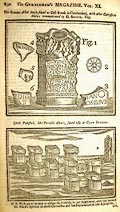 click to enlarge
click to enlargeG7410650.jpg
item:- roman altar; hypocaust; inscription, roman; roman inscription
 goto source
goto sourceGentleman's Magazine 1742 p.30 "The Inscription on the Roman Altar, and an Account of the other Figures. p.627 by George Smith Esq."
"Jovi optimo maximo
et Numinibus nostrae
Cohorti Secundae Tungrorum
Gordianorum Mille Equitum †
cataphractariorum Legionis
cui praesest Sicilius Claudianus, *
Praefectus instante Aelio Martirino
Principe decimo Kal. I. imperatoris
Dom. nostri Gordiani III. Pompeiano Consule"
"Or probably these last all in the Ablative."
" †Cohorts of Horse were most necessary to guard the Frontiers, but whether the Cataphractariorii were ever formed into regular Cohorts, Mr Ward knows better than I"
"*The CI is CL. for the bottom of these letters is destroy'd, and I read it Sicinus or Sicilius or Sicilianus Claudianus. I observed Something like an -ON before PRAFEC. But as they were very small to the rest, I shall not read them Pannonia,"
"In the N of MART N there seem'd to be a connection of an R I and O, which induces me to read it Martirino, but I think the Name hardly Roman, and submit to Mr Ward's reading."
"Fig.1. Is the Altar which was found in the bank of the Rivulet Cam beck near a very large Roman Fort, call'd Petrianis by Horsley, just where the wall of Severus crosses the said Rivulet; and removed by Mrs Appleby to her house at Cast-steeds where it now is."
"Fig.2. Is the Rota on the Side opposite to the fulmen. Fig.3. another Fragment of an Altar. Fig.4 and 5. are two curious pieces of a Glass bowl preserved by Mrs Appleby, one of them has the Name of Acteon in Greek capitals, cut with the adamant I suppose, and the other which is a Piece of the same Bowl, has a Dog's head fair on it, so that the Fable of that Prince has been engraved on the Bowl."
"Fig 6 Another fragment of a Stone, found at Cast-steeds."
"In the Wood where the fort has been, that Lady found some time ago buried in the Rubbish a regular Clay floor with several Pedestals upon it, and betwixt every two of them a hollow Parallelopipedon of burnt clay of 16 Inches long and 6 wide with a Hole thro' the opposite Sides.- The Use of these Pedestals is hard to be conjectured, unless to carry off the Damp from the Floor which was laid over it, but as Pipes went thro'these holes, it would rather seem like a Contrivance to warm a hot Bath, Mr Ward's Opinion about these would be of Service. I have drawn what are left of them, with the Form of the hollow Clay at A, but the Lady tells me there is not one fourth of them left that were there when She first discover'd it."
"Boothby Nov. 7. 1741."
"G Smith"
"Explanation of the Roman Altar and Figures; aforesaid by Mr Ward, Professor ef (sic) Rhetoric in Gresham College London."
"The INSCRIPTION."
"1. Jovi optimo maximo,
2. et numini domini
3. nostri, cohors secunda Tun-
4. grorum Gordiana millenaria equitum
5. centum quinquaginta, cui prae-
6. est Silius Clau-
7. dianus prae
8. fectus, instante
9. Aelio Martiano
10. Principe, decimo kal. I.
11. imperatore domino nostro Gordiano Augusto tertium Po-
12. mpeiano consulibus."
"Observations on the inscription."
"1. THERE can be no doubt, I think, but the first line ought to be thus supplied, which so often precedes et numini or numinibus in our British inscriptions; and the fulmen"
item:- roman inscription; roman altar; hypocaust
 goto source
goto sourceGentleman's Magazine 1742 p.31 "placed on the right side of the altar seems a corroborating proof of it."
"2. If the form of the character N at the beginning of the third line would admit of it standing for AV [ligature] the obvious reading here would be et numini Augusti; but as I understand it will not, the most probable reading that occurs to me is, et numini Domini nostri, the letter D being supplied at the end of the second line, Thus we have another British inscription with the words, et numini domini nostri Augusti, Horsley Northumb. LXXX; as Gordian is afterwards titled in this."
"3. The form of the character N for AN in the last line of this inscription seems to support the gentleman's opinion, who takes IW at the end of the third line to stand for Tun, and then no doubt Tungrorum "4. The insertion of the ancient M between the lines, which has been omitted by the workman, being placed over the word GOR. and before the following point, induces me to give it this reading. Vegetius speaking of the first cohort of a legion sais: Habet pedites mille centrum quinque, equites locatos centum triginta duos, et appellatur cohors miliaria Lib II. c.6. The cohort therefore received its name miliaria or millenaria from the number of common foot soldiers, who were a thousand, the additional hundred and five being subaltern officers, as Stewechius shews upon the place. Vegetius indeed ascribes these numbers both of the foot and horse only to the first cohort of a legion, and a less number of each to the other cohorts; but under the lower emperours, and especially in the provinces, it seems by inscriptions, as if those numbers were not always regularly observed. And therefore this second cohort, which was honoured with the name of the emperour, exceeded the common number both in the foot and horse, might possibly occasion its being particularly mentioned."
"7. I think the vacant space in this line after the letter D very well suits with the conjecture of the gentleman, who reads the name Claudianus."
"8. Instante here seems to denote the same as curante in some other British inscriptions, Horsl. DurhamPanegyr. c.18 sais Instant operibus, speaking of the officers, who directed the soldiers works."
"10. Princeps is a proper name, which occurs several times in Gruter. The small letter i placed in the belly of the L stands, as I suppose, for the name of the month, which might either be omitted at first, or placed in that manner for want of room."
"11. But the most considerable doubt which occurs in the inscription, is this; that it makes the Emperour Gordian colleague with Pompeianusfasti consulares ascribe to the second. Nor is any mention made of this third consulate any where, but here, and in another inscription given to us by GRUTER, p. MLXXXV. n.10; which I conclude therefore must be a mistake, especially since in several others of Gruter's inscriptions Pompeianus is joined with him in his second consulate, agreeably to the fasti."
"The two fragments of the glass bowl with the name AKTAI[O]N on one, and a dog's head on the other, cut with an adamant, as is supposed, are very curious. It is a great pity the bowl had not been preserved intire."
"The pedestals here mentioned as found in the wood, where the fort was, are, I suppose, pillars erected for the support of an hot bath, and the hollow instrument made of clay, a tube for carrying off the smoke. This will be more evident by comparing these remains with the draught of the hypocaust found at Lincoln, and published by the antiquary society of London. I wish a more accurate description had been given of the whole. the space it contain'd, and particularly the matter and dimensions of the pillars, as likewise whether any cinders or ashes were found there."
"J. WARD"
"N.B.The other, Letters concerning this Piece of Antiquity must be, referred to our next."
 goto source
goto sourceGentleman's Magazine 1742 p.135
"A learned Gentleman's Observations on the Roman Altar at Cast-Steeds, (see Vol.XI. p.656, and our two last, p.30. 76) communicated by G. Smith, Esq."
"Jovi optimo maximo et numini Augusti"
"Nostri Cohors Secunda Tungrorum milliaria equitibus centum quinquaginta cui praeest Claudius Claudianus praefectus instante Aulio Martiano decimo Kal. I. imperatore domino nostro Gordiano Augusto tertio Pompeiano Consulibus."
"Thus he reads tertio referring to Gordian the Third, and not the Times of his Consulship with Pompeianus; and tho' he judiciously observes that it was not usual to distinguish their Emperors by I. II. III. &c. yet having no Instances of three of the same Name so closely suc-"
item:- inscription, roman; roman inscription
 goto source
goto sourceGentleman's Magazine 1742 p.136 "[suc]ceeding one another, may assign the Reason for this being so."
"He inclines to read the Word effac'd in the second Line Augusti for Domini, but observes Instances may be given of both. He has, besides this ingenious Remark, that tho' the Cohort here mention'd was the Secunda Tungrorum, yet it might be the Prima of the Ala to which it appertain'd, and then there will be no Reason to suppose that there were two milliary Cohorts belonging to it."
"The Name of the Prefect is read Claudius (perhaps justly) for the S is least of all to be distinguish'd from the CC in its small Remains."
item:- hypocaust
 goto source
goto sourceGentleman's Magazine 1742 p.76
"A Letter from G. SMITH, Esq. concerning the Altar, &c. (See Vol.XI. p.650. and our last p.30.)"
"SIR,"
"I Have nothing to add, in relation to this Altar, being agreeably prevented by so judicious an Antiquary as Mr. Ward; what I have to say, shall be confin'd to the local Observation made a third Time at Cast-steeds, in order to satisfy his Enquiry."
"The Dimensions of the Hypocaustum are 5 yards by 9 within the Walls; the ground floor was of Clay in which the Stone Pedestals were fix'd, about 4 or 5 Inches deep more or less, so as to bring them to a perfect Level at Top, their Height including the Depth in the Clay is generally about 2 Foot; supported by these pedestals was a second Floor of white Stone about 1 Inch thick and curiously cemented for the Bath. The paralellopipedons of burnt Clay were plac'd quincunx form, betwixt every other Row of these pedestals, and were 5 or 6 Inches short of their Height, in order to give Passage for the Smoak to warm the Bath; a perspective Draught of what remain'd being sent you before, I shall here give you an ichnographical Plan of a few of them, in order to the better understanding the whole."
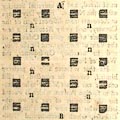 click to enlarge
click to enlargeG742E02.jpg
"Here the Squares represent the Ichnography of the Pedestals, and the n's that of the Clay Parallelopipedons which were omitted in every other Row, as A B. There were above 100 Pedestals in all, 2 Pedestals and the Vacuity took up above 28 Inches as near as can be judg'd from the present State of their Situation on the Floor."
"Mrs Appleby, who deserves to be gratefully remember'd by all Lovers of Antiquity, took great Pains to preserve what she cou'd of those valuable Remains of the Antients, she found there the Ruins of the Bottom and Sides of an Iron Grate, which that Lady still has at Cast-steeds, and some Pieces of Charcoal were lying up and down on the Floor."
"Adjoining to the South Wall where the Grate stood, were two curious Rooms, supported in the same manner with Pedestals, and Conduits betwixt them, still running fresh when that Lady found them, but on admission of the Air, all have gone to ruin. The Floors of these Rooms that rested on the Pedestals, were pav'd in the same manner as the Bath, with this Addition, that a curious cemented Composition of Lime, Brick-dust, and Pebbles, at least 4 Iinches thick was spread over the Stone of a wonderful Hardness. Such Care have that warlike People taken to render a Climate of these Northern Regions agreeable to their Constitutions."
"There were many other curious Floors found amongst the Ruins, and some Coal-ashes; but I am apt to believe, that the old Castle of the de Vallibus, Proprietors of Gillsland after the Conquest, has been built on the Ruins of this Fort, because several Curiosities that intimate a more modern Date have been found here. It stands, as most other Roman Forts have done, on a Lingula, as near as the Defence of the Wall wou'd admit, betwixt the Rivulets of Irthing and Cammock."
"There was also a cold Bath found near the Place, and not far from it something like a Cistern, about 5 Yards by 1 and a half, compos'd of thick Slate Stones very large set edge-ways, curiously cemented so as to refuse Passage to any Liquid, on Supposition that it might be intended for such a Design."
"The Glass Bowl is very curious, but the Fragments not being at the Edge any where, 'tis impossible to judge of its capacity. One of the Pieces is about 1 Inch, 8 tenths length-ways, and 1 tenth cross, or to speak Mathematically, the chord is about 1 Inch 3 tenths long, and the Sagitta or vers'd Sine 1 tenth, wherefore the Diameter ought to be 8 Inches 1 tenth at the Place, but these are extremely difficult in such small Arches to be accurately determin'd. No doubt but the Fable of Actaeon was the History on the Bowl, and 'tis great pity it had not been intire."
"G. SMITH"
"P.S. I have just now received the Jan. Magazine, there are two Mistakes in the printing Cohorte for Cohortis, and Consule for Consulibus, in my first reading."
"N.B. The learned Dr. Gale's Remarks on this Altar, must be left to our next."
placename:- Cast Steeds
item:- inscription, roman; roman inscription
 goto source
goto sourceGentleman's Magazine 1747 p.60
 click to enlarge
click to enlargeG7470060.jpg
placename:- Castlesteads
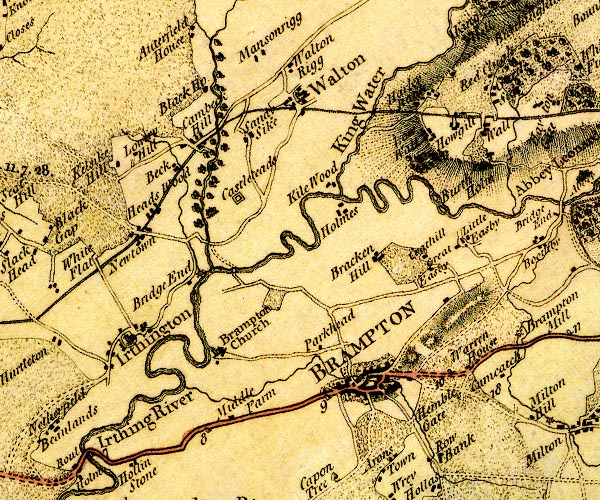
D4NY56SW.jpg
"Castlesteads"
square within a square; roman fort
item:- Carlisle Library : Map 2
Image © Carlisle Library
placename:- Petriana
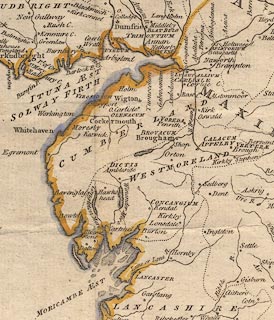 click to enlarge
click to enlargePEN1Cm.jpg
"Petriana"
square; roman camp on Hadrian's Wall
item:- private collection : 66
Image © see bottom of page
placename:- Castlesteads
 goto source
goto sourcePage 105:- "..."
"I do not find any ancient authors mention a castle here [Castlerigg], Speed, who speaks of twenty-five in Cumberland, hath found out every one I ever heard or knew of, except Kirkoswald; how that has escaped him I cannot tell. I shall here put down their names, and, as well as I can, their most ancient owners, and supposed founders."
"..."
 goto source
goto sourcePage 106:- "..."
"5. CASTLESTEADS, - By the Romans, close by the Picts wall, but has been long in ruins; was once the seat of the Moultons - Camb."
"..."
placename:- Cambeck Fort
placename:- Castle Steeds
 goto source
goto sourcePage 227, Mr Horsley:- "..."
""CAMBECK fort, usually called Castle-steeds, is all grown over with wood, yet the boundaries of it may be traced out. It seems to have been about six chains square. It is detached to the south about 12 chains from the wall.""
placename:- Castlesteeds
placename:- Cambeck Fort
placename:- Voreda
placename:- Petriana
item:- roman inscription; inscription, roman; roman altar; altar, roman; hypocaust
 goto source
goto sourcePage 201:- "..."
"The fort of Castlesteeds is almost opposite to Brampton, and stands on the south-east of Cambeck on a rising ground about a mile from and within the wall. It is an oblong square: from the south-east front the ground declines to the river Irthing; on which ground are visible foundations of walls and streets, but removed for the sake of buildings and tillage. On the other side is a steep bank, under which the Cammock beck or Cambeck runs coming from the wall. The outwalls are for the most part erased, probably to build a large dwelling-house, which from it takes the name of Castlesteed, and it still yields good stone of all sizes for building, most of them black as if the whole building had been burnt, and great numbers of iron nails, pieces of iron and brass run into lumps though now mouldering have been found; also square tiles about an inch thick with a ledge on one edge to hang them on roofs about 10 inches by 9, and of a yellow close earth, many earthen vessels of different shapes and colours broken in digging. The longest sides of the fort are about four Gunter's chains, and the shortest about two and an half. There are several foundations of houses still standing there pretty high but hard to come at for the bushes. A small cornelian seal was found some years ago, and several inscriptions, of which Mr. Goodman of Carlisle sent copies to Mr. Gale."
"Mr. Goodman had two pieces of cast brass, each 36lb. weight, found in a peat moss two feet deep adjoining to the Roman road in Cumberland, supposed heads of a catapulta. Sir Joseph Aylosse shewed them to the Society of Antiquaries 1736, and a model was made for them in wood."
"At Cambeck fort or Castlesteeds in Irthington parish (the only place to which the name of Castlesteeds has been given, it being the general name given to all the military castella), Mr. Horsley places VOREDA or PETRIANA of the Notitia. It is all grown over with wood, yet the boundaries may be traced. It seems to have been about six chains square, and is detached from the wall to the south about 12 chains. To this belong the the ten following inscriptions:"
"1. COH
VIIII."
"found in the wall near a cottage called Randylands, more than half way from hence to Burdoswald; the letters well cut."
 goto source
goto sourcePage 202:- "2. CIVITATECAT
VVELLλVN
ORUM. TOIS
EDIO."
"E civitate Catuvellaunorum Titus Oisedio posuit. This is in the fore wall of a house at Howgill about half a mile farther west than Randylands. It commemorates the people called by (Dio LX.20.)
"3. Two reliefs, now at Netherby, before-mentioned."
"4. LEG. VI. V
...... F"
"found in the east part of the station near the gate."
"5. An altar removed to Kirklinton, and now at Netherby, found with the face downward near Brampton near the east entry as if in the south jamb of the gate with several pieces of pots or urns, &c.."
"The inscription is to be read,"
"... omnium
gentium
templum
olim vetus
tate conlab
sum Gaius Julius
Pitanus
provinciae praeses restituit."
"Over the first lines are traces of BVS, whence Mr. Gale and Mr. Ward conjecture VICTORIBVS as on the coins of Constantine, Constantius, Chlorus, and Maximian, VICTOR OMNIVM GENTIVM."
"6. DEO SANG M
ARTI VENVSTIN
VS LVPVS VSLM."
"Discovered by Mr. Gordon who gave it to lord Hertford. Four more before-mentioned at Scaleby castle. Here have been also found several curious stones cut with cross lines lattice fashion, like that at Harlow hill, Northumberland, Horsl. XXXI. A small bronze figure, bearded, with curled hair, was found here 1766."
"An altar, having on one side a kind of double trident, on another a patera, and on a 3d the inscription, Pl.XIII. fig.13. It was dug up here about 60 years before and buried again in lord Carlisle's wear, with two or three more inscribed stones, as some old men related. On repairing the wear 1741, it was sought for, and carried by Mrs. Appleby's order to the court of her house there. The inscription is thus read by professor Ward:"
"Jovi optimo maximo
et numini domini
nostri cohors secunda Tun-
grorum Gordiana millenaria equitum
centum quinquaginta cui prae-
est Silius * Clau-
dianus prae-
fectus instante
Aelio Martiano
Principe decimo kal. J.
imperatore domino nostro Gordiano Augusto tertium Po-
mpeiano consulibus."
"We have numini domini nostri in Horlsey's Northumberland, LXXX. Instante is equivalent to curante on some other inscription. But the most considerable doubt which occurs in the inscription is that it makes the emperor Gordian colleague with Pompeianus in his 3d consulate, which the Fasti consulares ascribe to his 2d. Nor is any mention made of this 3d consulate anywhere but here and in another inscription given to us by Gruter, p.MLXXV. 10. which Mr. Ward concludes, therefore, must be a mistake, especially since in several of Gruter's inscriptions Pompeianus is joined with him in his 2d consulate agreeably to the Fasti. The two fragments of the glass bowl with the name AKTAIΩN on one and a dog's head on the other, cut, as supposed, with an adamant, are very curious."
"Mr. Gale observes, that the cohors mentioned here, though inferior in number, seem to have had the preference in dignity, being also honoured with the name Gordiana after the emperor. It must also have been the first cohort of the legion it belonged to; for Vegetius tells us, that the first cohort of the legion was called Milliaria, and consisted of 1105 foot and 132 horse; and as the several cohorts of a legion and their auxiliaries bore the same proportion to each other, so the first auxiliary cohort must have contained as many in number as the first legionary cohort, and though this might have been the 2d of the Tungri as perhaps levied after the first, it might be the first of the wing to which it belonged, and dignified with these honourable titles for some peculiar merit. Neither is it improbable that it might belong to the Ala Aug. Gordiana ob virtutem appellata quartered in this country. Mr. Gale was further of opinion, that CL must be numeral, for though the true number of horse in a cohort is said to be no more than 132, as that was not always certain, especially in the lower empire, this cohort of Tungri might chance to have a few more in it than usual, and that might be a very good reason to express it on this stone, it being of some consideration to be more numerous than the others. Instante may occur in the very imperfect inscription given by Horsley, Scotland, 7. XXXIX. INS. So we have --- instans operi regnisque futuris, AEn. I. 504. and instans operibus, Plin. Paneg. c.18. Princ for Principe in the ninth line is the proper name of a man, and occurs often in Gruter. There being no cross stroke in the N of MARTIN it is to be read Martino not Martiano. X KALI is decimo kal. Januarii, Junii, or Julii. IMP DNG AVG III. he believed must be read Imperatore Domino nostro Gordinano Augusto tertio, and what follows, Pompeiano consulibus, and that it is no mistake of the emperor being the 3d time consul instead of the 2d, for in Gruter he is mentioned as consul the 2d time with"
 goto source
goto sourcePage 203:- "Pompeianus, and as it was in the 4th year of his reign that he was consul with him, these numerals cannot refer to a 3d consulate which he never took, but must relate to his being the 3d emperor of that name. If it be objected that it was not usual for the Roman emperors to style themselves I. II. III. Mr. Gale answers that there never were three of the same name thus nearly preceding each other as the three Gordians, if at any time: however, the inscription in Gruter, p.MLXXXV. must include a mistake where it represents this Gordianus P.M. TRIB. POT. COS. III. P.P. the III. immediately followed COS, and so cannot be applied to any other word, but is a palpable mistake of the stone-cutter."
"In the wood where the fort has been Mr. Appleby found a Roman hypocaust, a regular clay floor with above 100 pillars on it about two feet high, and between every two of them a hollow parallelopipedon of burnt clay, 16 inches long and six wide, with a hole through the opposite side serving as flues. It was five yards by nine within the walls: and on the pillars was another floor of white stone, about an inch thick, curiously cemented for the bath. There was also found the bottom and sides of an iron grate, and some pieces of charcoal were lying scattered up and down on the floor. Adjoining to the south wall where the grate stood were two rooms, supported in the same manner with pillars and flues, and the floors paved as the baths with the addition of a curious cemented composition of lime, brick, dust, and pebbles, at least four inches thick, spread over the stone, of a wonderful hardness. Many other curious floors were found among the ruins and some coal-ashes: but these were supposed of later date, as well as several other articles found here. There was also a cold bath found near the place, and not far from it something like a cistern about five yards by 1½, composed of thick slate stones, very large and set edgewise, well cemented together."
"The two inscriptions, mentioned by Mr. Camden, as discovered at Castlesteeds and Trederman hard by, Mr. Horsley could no where find. Trederman is much nearer Burdoswald than Cambeck, and there is nothing of Roman antiquity in that castle or about it: nor are they at Naworth, where is half an altar standing in a gate, which Mr. Horsley could not think had any relation to them. There is also a large altar built up in the jamb of a chimney at Whitefield, about a mile west from this fort, which the old people said was brought from hence or a part of the wall very near it. But it is so defaced that not a letter is visible on it. No decisive conjectures can therefore be offered on these two inscriptions."
"In Holland's edition is the following inscription given as lately found on a fair votive altar erected to the goddess Nymphe of the Brigantes for the health of the empress Plautilla wife to M. Aurelius Antoninus Severus, and the whole imperial family by Cocceius Nigrinus, a treasurer to the emperor, when Laetus was 2d time consul:"
"DEAE NYMPHAE BRIG
QVOD VOVERAT PRO
SALVTE PLAVTILLAE CO. INVICTAE
DOM. NOSTRI INVICTI
IMP. M. AVRELII SEVERI
ANTONII PII FEL. CAES.
AVG. TOTIVSQVE DO
MVS DIVINAE EJVS
M. COCCEIVS NIGRINVS
Q. AVG. N. DEVOTVS
LIBENS SVSCEPTVM S
LAETO II..."
"which intricate connexion of letters the Doctor read,"
"Deae Nymphae Brigantum
Quod voverat pro
Salute Plautillae conjugis invictae
Domini nostri invicti
Imperatoris Marci Aurelii Severi
Antonii pii felicis Caesaris
Augusti totiusque do
mus divinae ejus
M. Cocceius Nigrinus
Quaestor Augusti numini devotus
Libens susceptum solvit
Laeto II..."
"It is not in the additions to the edition of 1722, nor could Mr. Horsley find it, but he was of opinion it should be referred to some part near Cambeck or Brampton."
"..."
placename:- Castle Steeds
placename:- Castle Place
item:- roman inscription; inscription, roman; hypocaust
 goto source
goto sourcePage 176:- "... Under this [?Brampton] and at Castle steeds, q.d. Castle place, as also at Trederman were found these inscriptions, which the right hon. lord William Howard of Naworth, 3d son of the most noble Thomas duke of Norfolk, and an attentive and learned searcher into venerable antiquity, who possesses estates hereabouts in right of his wife, sister and coheir of the last baron Dacre, copied for me with his own hand: See Pl. VIII. fig.8 The following there also in an antient hypocaust, in which the name of the Legatus Augusti and Propraetor in Britain is unfortunately lost: See Pl. VIII. fig.9."
placename:- Roman Casteads
 goto source
goto sourcePage 108:- "... Walton House ... built on the side of the Roman Casteads (sic). Several Roman remains dug up at this station are preserved here. ..."
placename:- Petriana
item:- inscription, roman; roman inscription
 goto source
goto sourceGentleman's Magazine 1860 part 1 p.347 "..."
"... we have in the Notitia list, after the mention of the Tribune of the first AElian Cohort of Dacians at Amboglanna, the following entry:-"
"Praefectus Alae Petrianae Petrianis."
"From this circumstance it has been inferred that Walton House, the station next west from Amboglanna, is the Petriana of the Notitia."
"Unfortunately we have met with no stony record of Ala Petriana at Walton House, though we have three of the Second Cohort of the Tungri, and one of the Fourth Cohort of the Gauls."
"By comparing the stones found at the various stations with the Notitia list, the names of the stations on the Wall between Wallsend and Birdoswald have been ascertained with certainty; westward of this, all is involved in comparative doubt. Had this stone been found at Walton House, it would have gone far to confirm the reasonings of antiquaries that this was Petriana. In all probablity this ala had not then taken up its position upon the Wall. The Wall at the time this slab was cut was probably only in the process of erection. The letters are clearly cut and well formed; no ligatures are introduced; even the letters composing the diphthongs are not tied together. The style of the lettering indicates an early date, probably not later than the Riveling rescript in the time of Hadrian."
"If, as it seems probable from the size and character of the slab, it was attached to a building erected by the Prefect of the Ala, we may infer that this body of troops were at this time resident in Roman Carlisle. Had the inscription occurred on an altar, it might have been made when they were only resting there for a brief space."
"In no other inscription found in Britain except this are we informed that the Ala Petriana was entitled to the epithet of Augustus; that it consisted of a thousand men; that it was composed solely of Roman citizens; and for the first time the epithet Torquata occurs, as applied either to this body of troops or any other in Britain. As the troop was in Britain when Hadrian was, it may have received the epithet of Augusta for some deed of valour done in his presence. It seems too, to have consisted of 1,000 strong. It must have been much reduced in size before it took up its quarters in the Walton House station, which has an area of only 23/4acres. It was at this time only recruited from the ranks of persons who, like the Apostle Paul, could boast of being Roman citizens. In the lower periods of the Empire this rule was probably departed from; though, indeed, the privilege was then so widely diffused as to become of little value. The epithet torquatus has not before been found in Britain as applied to any body of troops. It was a distinction of great rarity. ..."
 goto source
goto sourceGentleman's Magazine 1860 part 1 p.348 "..."
"The origin of the name Petriana is uncertain. It seems clear now that the ala did not take its name from the station (Walton House or Cambeck Fort) in which it was quartered, but that it had it before coming to Britain. How it arose is not known."
"It may be necessary to remark that the ala or wings of the Roman army were always cavalry, and were auxiliary troops, not native Italians."
"The origin of the name Petriana is uncertain. It seems clear now that the ala did not take its name from the station (Walton House or Cambeck Fort) in which it was quartered, but that it had it before coming to Britain. How it arose is not known."
"It may be necessary to remark that the ala or wings of the Roman army were always cavalry, and were auxiliary troops, not native Italians."
placename:- Camboglanna
placename:- Gabaglanda
placename:- Cambroianna
placename:- Amboglanna
placename:- Castlesteeds
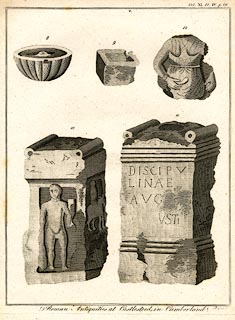 click to enlarge
click to enlargePR0265.jpg
Plate 11, figures 8 to 12 of vol.11 p.66; two roman altars and other items.
printed at bottom right, centre:- "[Basire Sc] / Roman Antiquities at Castlesteeds in Cumberland."
item:- Dove Cottage : 2008.107.265
Image © see bottom of page
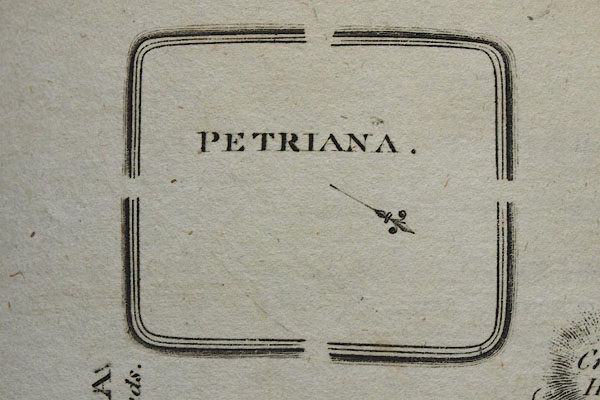
BOX03.jpg From Hutchinson 1794 map 2.
"PETRIANA"
